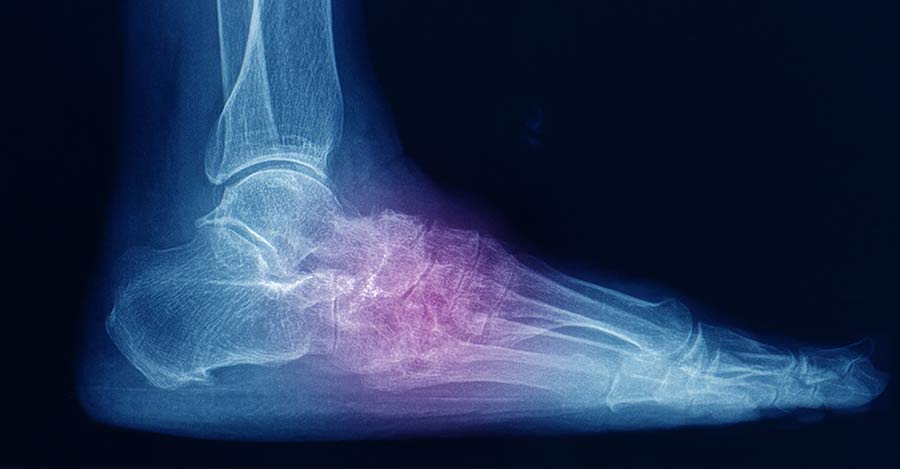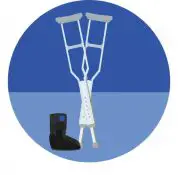Lisfranc Injury: Surgery, Treatment and Recovery Time
Not every foot injury is easy to diagnose. Many injuries associated with the foot can be complex. Some will need extensive examination and treatment. If you’re suffering from a foot injury, you might have a Lisfranc foot injury.
Healthcare professionals often miss these rare injuries. That’s why it’s best to do your research on the topic. This article will discuss what a Lisfranc foot injury is, its causes, and the treatment options. We will also look at the estimated recovery time.
Where is the Lisfranc joint?
A Lisfranc joint is the point where the long bones and bones in the arch of a person’s foot connect. The long bones are the bones that end at the point of your toes.
The Lisfranc itself is a ligament. This ligament is a hardy strip of tissue that joins these bones together. Your Lisfranc ligament, along with your Lisfranc joint, are crucial. They ensure your foot maintains its strength and stays in proper alignment.
What Is A Lisfranc Foot Injury?

If a doctor says that you have a Lisfranc foot injury, he means that you have hurt the Lisfranc joint. Yet, the doctor could also mean that you have injured the Lisfranc ligament in the middle of your foot. Essentially this type of injury is located around the arch of your foot which is the point of joining.
When it comes to Lisfranc injuries, there are three different types. Namely, these types are sprains, discolorations, and fractures. Yet, it’s important to note that a Lisfranc foot injury could often be an amalgamation of these three types. Additionally, it could also affect other anatomical parts in your foot.
An injury to your Lisfranc joint or ligament is serious, which is why it needs to be diagnosed promptly. If you don’t seek proper treatment, this type of injury could negatively affect how you run, walk, and stand.
Is A Lisfranc Foot Injury Rare?
It’s likely that before reading this article, you were not aware of what a Lisfranc injury was. This is because Lisfranc injuries are relatively rare. According to health care experts, Lisfranc injuries only affect every 1 in 55,000 to 60,000 globally each year.
Additionally, approximately 30 percent of Lisfranc injuries are missed by healthcare providers. Moreover, these injuries are commonly missed at an initial consultation. Often those who aren’t foot and ankle specialists miss this type of injury. This can have severe repercussions and long-term implications. Some of these implications include foot deformities, osteoarthritis, and chronic pain. That’s why you must seek out a healthcare specialist if you believe you are suffering from this type of injury.
Currently, trying to diagnose a Lisfranc injury can be tricky. This is because the signs of injury are very subtle during examination and imagining. Yet, in recent years Lisfranc injury diagnosis practices have been receiving in-depth study. Foot and ankle specialists are looking at ways to diagnose this type of foot injury better. Many believe that they have been making progress.
What Causes A Lisfranc Foot Injury?
Now that we know what a Lisfranc foot injury is, we can look at what cause a Lisfranc foot injury. Lisfranc foot injuries can occur with motor vehicle accident victims. This injury is clear to see when a foot was caught in a floorboard. A Lisfranc foot injury is also more frequent amongst athletes. Often when an athlete plants their foot and twists it, they sustain a Lisfranc foot injury.
Lisfranc foot injury can happen to anyone. Many people have sustained a Lisfranc foot injury from missing a step when walking. Others have developed this injury from having a minor slip and fall accident. Moreover, this type of injury also occurs when your foot sustains a direct trauma injury. Often a direct trauma involves a heavy thing falling on your foot.
The Diagnosis Of A Lisfranc Foot Injury

In some instances, Lisfranc injuries are mistaken for ankle sprains. That is why the diagnosis process is vital. Before an accurate diagnosis can be given, a foot and ankle specialist will conduct an exam. They will also ask a series of questions. Usually, they will ask you how you hurt your foot and when you hurt it. After you have answered the doctor, they will examine your foot and see how severe the injury is.
To properly determine if you have a Lisfranc foot injury, it is likely that you will need to go for imaging studies. An unweighted specialized X-ray will show your practitioner if you have a midfoot dislocation. It will also let them know if you broke the bone. Moreover, it will also show if you tore your Lisfranc ligament or if there is a rupture.
Additionally, you might have to have an examination by a surgeon. They will examine you while you are under anesthesia. This is because a surgeon may want to diagnose the best course of action during surgery.
The Symptoms Associated With A Lisfranc Foot Injury
The symptoms of a Lisfranc foot injury can be challenging to determine. This is because what you feel will depend on how severe the injury is. A few people feel the same pain level as they would with an ankle sprain. Yet, others feel debilitating pain. Below are the common symptoms seen by those experiencing a Lisfranc foot injury.
- Swelling of the entire foot or around the arch of a foot.
- Minor to significant bruising and discoloration at the bottom of a foot.
- When a foot widens unnaturally.
- Bruising found at the arch of a foot.
- Blisters found at the arch of feet.
- Minor to intense pain felt when weight is put on a foot.
- When a foot is not able to bear a person’s weight.
Treatment ( Surgical Vs. Non-Surgical )
Ultimately, the type of treatment you receive for your Lisfranc foot injury will depend on how severe it is. There are non-surgical treatment options and surgical treatment options. The latter is more common. It’s essential to be aware of both treatment options. That way, you can determine the best course of action.
Non-Surgical
If you have not broken a bone or torn your Lisfranc ligament, you likely have a minor injury. In this case, you probably won’t need surgical intervention. The treatment procedures for a slight Lisfranc foot injury is like how a doctor would tell you to treat a sprain.
If you have not broken a bone or torn your Lisfranc ligament, you likely have a minor injury. In this case, you probably won’t need surgical intervention. The treatment procedures for a slight Lisfranc foot injury is like how a doctor would tell you to treat a sprain.
You will likely need to follow the RICE treatment method. This method involves resting, icing, and elevating one’s foot. Following this treatment method will reduce swelling around the midfoot and the pain. Your injury will also heal faster.
Sometimes the RICE method does not work on its own. For pain management, some people need to use pain medication. Those with a Lisfranc foot injury should consider using anti-inflammatory medicines.
Additionally, those with a minor Lisfranc foot injury might need to keep weight off the injury. Usually, you will need to keep your weight off the hurt foot for 6 weeks while your Lisfranc foot injury heals. If you need to keep your weight off your foot, you should consider using a mobility aid. For example, crutches. They will help you heal without you re-injuring your foot.
Moreover, the final stage in your non-surgical treatment plan will generally involve physiotherapy. A physical therapist will create a treatment plan to help you restore your foot’s strength.
Surgical
Do you have a dislocated or fractured Lisfranc joint or torn Lisfranc ligaments? If so, you will most likely need surgery. The surgeon’s goal will be to realign the broken or fractured bones in your foot or repair any ligament tears. You will have to undergo one of two different types of surgical treatments.
Many healthcare experts believe fusion is the best option for long-term pain management. We have spoken of the two surgical treatments below.
An Open Reduction Fixation Surgical Procedure
You might need to undergo two surgeries if you need this procedure. This procedure usually involves a surgeon using permanent or temporary hardware. This hardware will keep the bones together. Some of the hardware the surgeon could use includes screws, metal plates, or fiber tape. You will need a second surgery if the surgeon uses temporary hardware.
A Fusion Surgical Procedure
A fusion surgery will use medical hardware that is permanent. When you undergo a fusion surgery procedure, the bones in the arch of your foot will be made into a solid piece. This will be done by fusing or welding them into place.
Recovery Time And Rehabilitative Time
The approximate length of the recovery time, and what rehabilitative methods will you need if you have a Lisfranc foot injury? The answer will ultimately be conditional to the severity of your Lisfranc injury.
If you have a minor Lisfranc foot injury, it usually takes around six months to properly heal. In contrast, a Lisfranc injury that needs surgery will need a recovery time of a minimum of three months to approximately five months.
Lisfranc injuries will need the RICE rehabilitative method, along with a weight-bearing reduction. Those suffering this injury type should also not engage in any high-impact tasks and ventures.
Walking With A Lisfranc Foot Injury

Do you have a Lisfranc foot injury? If so, you need to alter how you walk. This might seem to be a drastic measure, but it’s crucial to your recovery.
Usually, your doctor will tell you to keep weight off your hurt foot for about a month. In theory, this sounds easy, but for those who are active, it can be quite difficult. Fortunately, there are several mobility aids available. These will assist you with changing how you walk to optimize your recovery.
- Traditional adjustable crutches
- Hands-free mobility crutches
- Knee walkers
- Knee scooters
- Wheelchairs
- Powerchairs
Final Words
Now that you know what a Lisfranc injury is, you will better understand if you are suffering from one. These injuries are relatively rare. With this being the case, you need to ensure you visit a doctor who specializes in foot injuries. If a Lisfranc injury is not treated, it can have devastating long-term health effects.
With the right treatment plan and mobility aid, you can recover in a matter of months. Try to learn the causes, symptoms, and treatment options available for Lisfranc injuries. If you understand them, you will be better prepared should you ever suffer this type of injury.


